Archive for January, 2013
Crème de la crème
31 January 2013 | Fiction, Prose
Such straining and pasteurising is going on in the city that Arabs and other Muslims, the unemployed, drunkards, poor people and lunatics have been eliminated. By chance I became a cultural figure, and I was invited to a cultural evening whose invitation had been personally written by the Anarchist. At the restaurant table sat the Anarchist, the Psychoanalyst and the Psychologist’s boyfriend, 20 years younger, the Journalist, the Gift-Shop Owner, a Librarian and the Deputy Rector of a community college. Accompanying me to the restaurant, too, were the Wolf and the Deer, who hadn’t been invited. Sparse white fur grew on the Wolf’s narrow muzzle and there were teeth missing from his mouth. The Deer was beautiful, with huge eyes. And of course both of them were drunk. I asked them to come along because I believed that intellectuals are warm-hearted and open-minded. A really dumb idea. More…
Osmo Jussila: Neuvostoliiton tragedia. Utopiasta vankileirien saaristoksi [The tragedy of the Soviet Union. From utopia to Gulag Archipelago]
31 January 2013 | Mini reviews, Reviews
 Neuvostoliiton tragedia. Utopiasta vankileirien saaristoksi
Neuvostoliiton tragedia. Utopiasta vankileirien saaristoksi
[The tragedy of the Soviet Union. From utopia to Gulag Archipelago]
Helsinki: Otava, 2012. 448 p., ill.
ISBN 978-951-1-26521-4
€32.80, hardback
The acclaimed Russian and Soviet history scholar Osmo Jussila examines the early history of the Soviet Union from a fresh perspective. He shows how, in the years following the 1917 Revolution, an originally positive idea for a better society turned into a bureaucratic tyranny. The Soviet Union’s strong man V.I. Lenin created the Bolshevist Party as a paramilitary organisation which managed to seize power in October 1917. Even in the early years of Soviet power the ‘Red Terror’ crushed its opponents with executions and the establishment of prison camps. Although Lenin was a good professional revolutionary, he was almost incapable of building a new society: his solutions were often cruel, arbitrary and hasty. Jussila’s general view of Lenin is in line with the ideas that are familiar from more recent historical research, but the author also focuses and deepens his analysis to provide an essentially complete picture of Soviet Russia’s chaotic development and of Lenin’s role in the formation of the oppressive Soviet state.
Translated by David McDuff
Future, fantasy and everyday life: books for young readers
24 January 2013 | Articles, Children's books, Non-fiction
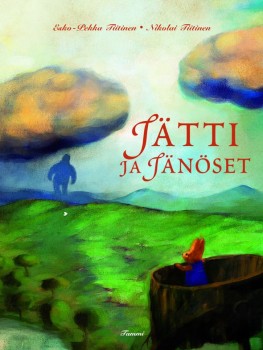
A giant meets the bunnies: a new story by Esko-Pekka Tiitinen, illustrated by Nikolai Tiitinen
Fantasy novels and dystopias feature in the new Finnish fiction for young readers; popular children’s books are recycled – stories and illustrations are adapted to new media and for new age groups. Päivi Heikkilä-Halttunen takes a look at new books for young readers published in 2012
All new mothers in Finland receive a ‘maternity package’ from the state containing items for the baby (including bedding, clothing and various childcare products) intended to give each baby a good start in life. This tradition, which started in 1938, is believed to be the only such programme in the world.
Each package also contains the baby’s first book, traditionally a sturdy board book by a Finnish author. The past few years have seen more original board books published in Finland than ever before: they are doing well in competition alongside books translated from other languages. Board books for babies have become a focus for Finnish illustrators and graphic artists. These books, with their simple visual language, have taken on a retro look.
History was made with the Finlandia Junior award, when for the first time the prestigious prize was given to a picture book originally written in Finland-Swedish: Det vindunderliga ägget (‘A most extraordinary egg’, Schildts & Söderströms) by Christel Rönns. The award can also be seen as an acknowledgement of the brave, experimental Finland-Swedish children’s picture books that are being published these days. Finnish-language picture books, on the other hand, are still crying out for more figures to shake up traditional practices. More…
Seita Vuorela: Karikko [The reef]
24 January 2013 | Mini reviews, Reviews
 Karikko
Karikko
[The reef]
Kuvitus [Ill. by]: Jani Ikonen
Helsinki: WSOY, 2012. 357 pp., ill.
ISBN 978-951-0-38640-8
€28.90, hardback
Karikko is a self-assured work, aware of its odd charm. It is intended for readers who prefer not to have pre-digested material fed to them; this book has been classified as both a young adult and adult book. Vuorela (née Parkkola) is excellent proof that the global boom in fantasy literature can be harnessed in support of an author’s own artistic ambitions to reinvigorate the genre. She has also crossed a difficult barrier by making it into the American publishing market. Karikko delves into feelings of decay, devastation and abandonment. The text is redolent with the smells of seaweed and mildew; there are textures pockmarked with rust and the melancholy of abandoned homes. At the centre of Karikko is a family with mismatched siblings – 14-year-old Mitja and his elder brother Waldemar – as well as abandonment, sorrow and guilt. Seita Vuorela structures her plot as a mosaic with flashbacks, foreshadowing and random bits. This technique is quite challenging for the reader but ultimately rewarding.
Translated by Ruth Urbom
Mila Teräs & Karoliina Pertamo: Elli ja tuttisuu [Elli and the dummy]
24 January 2013 | Mini reviews, Reviews
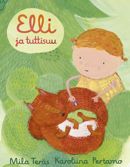 Elli ja tuttisuu
Elli ja tuttisuu
[Elli and the dummy]
Kuvitus [Ill. by]: Karoliina Pertamo
Helsinki: Otava, 2012. 31 pp.
ISBN 978-951-1-26045-5
€16.90, hardback
The new Elli series of picture books continues the tradition in Finnish children’s literature of giving an idyllic portrayal of the natural world: even a small child and her parents have time to marvel at nature together. In reality, more and more children are becoming estranged from their natural surroundings. Elli is an energetic little two-year-old whose mother encourages her to give away her beloved dummy (pacifier) to a young squirrel in the garden. This book tells a typical story about everyday life that will reinforce children’s self-esteem and sense of identity, but fortunately Elli is also allowed to be a little girl who needs looking after by her parents. Our performance-obsessed society expects nearly superhuman effort and skills even from children, so it is important that kids are allowed to be kids – in children’s literature, at least. Karoliina Pertamo’s illustrations glow with warm, invigorating colours. Pertamo (b. 1971) has quickly established a highly individual illustration style for herself.
Translated by Ruth Urbom
Esko-Pekka Tiitinen & Nikolai Tiitinen: Jätti ja jänöset [The giant and the bunnies]
24 January 2013 | Mini reviews, Reviews
 Jätti ja jänöset
Jätti ja jänöset
[The giant and the bunnies]
Kuvitus [Ill. by]: Nikolai Tiitinen.
Helsinki: Tammi, 2012. 25 pp., ill.
ISBN 978-951-31-6573-4
€19.90, hardback
This powerful allegory set in the animal kingdom is a tale of global inequality – with a lovely, take-it-easy, imaginative approach that emphasises tolerance and respect for nature. The rabbit community is shaken up when an arrogant giant barges into their territory. At first, the rabbits try to take an understanding view of the interloper, but he ends up in grave danger as a result of his own actions. Only the actions of the kind-hearted rabbits can save him. The calm tone and engaging pace of Esko-Pekka Tiitinen’s story make it ideal for reading out loud. It has the timeless enchantment of traditional animal fairy tales. The mixed-media illustrations by Esko-Pekka Tiitinen’s son Nikolai radiate warmth and a sense of togetherness, but also power, hatred and estrangement where necessary. The seamlessly integrated text and illustrations create an enjoyable reading and visual experience for children and adults in much the same vein as Herra Kuningas (‘Mister King’, Otava, 1986) by Raija Siekkinen and Hannu Taina, which has already joined the ranks of classic Finnish children’s titles.’
Translated by Ruth Urbom
Christel Rönns: Det vidunderliga ägget [A most extraordinary egg]
24 January 2013 | Mini reviews, Reviews
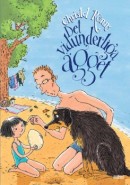 Det vidunderliga ägget
Det vidunderliga ägget
[A most extraordinary egg]
Kuvitus [Ill. by]: Christel Rönns
Helsingfors: Söderströms / Stockholm: Bonnier Carlsen Bokförlag, 2012. 32 p., ill.
ISBN 978-91-638-6857-3
€16.90, hardback
Finnish edition:
Perin erikoinen muna
Suom. [Translated by] Mirjam Ilvas
Helsinki: Tammi, 2012. 30 p., ill.
ISBN 978-951-523-183-3
€15.90, hardback
This is the third work that the graphic designer and illustrator Christel Rönns (born 1960) has written in her own right. With her relaxed and humorous illustration style, Rönns has provided the visual component of some 60 children’s books. This story portrays a family – parents, two little girls and a dog (the author has dedicated her book to the memory of her hovawart dog Freja who died at 14). One summer’s day they find a large egg on the beach and bring it home. But the egg, dropped by accident, reveals a little four-legged creature: named Koi-Koi, it turns out to be delightfully friendly and playful. Nobody actually knows what it is – not even a professor of zoology – but it eats and grows to an enormous size, so the house becomes very cramped (and Koi-Koi’s massive farts send the family running…). But then Koi-Koi begins to disappear at night, and one day he doesn’t come back. Missing a lost pet is a new feeling for the girls (their parents must be secretly relieved, as must the dog!). The story is both funny and gently melancholy, the illustrations detailed and humorous. The book was awarded the Finlandia Junior Prize in 2012.
Sari Peltoniemi: Gattonautti ja muita arkisatuja [The cattonaut and other everyday tales]
24 January 2013 | Mini reviews, Reviews
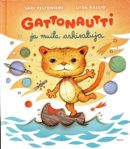 Gattonautti ja muita arkisatuja
Gattonautti ja muita arkisatuja
[The cattonaut and other everyday tales]
Kuvitus [Ill. by]: Liisa Kallio
Helsinki: Tammi, 2012. 67 pp.
ISBN 978-951-31-6576-5
€19.90, hardback
There has been a desperate shortage of short stories and fairy tales for a long time. Now Sari Peltoniemi has bravely risen to this challenge. In her previous young adult novels, she cultivated the ‘new weird’ genre, in which strange and fantastical elements encroach on everyday life. This collection can be categorised as the first Finnish children’s book that makes use of that fantasy subgenre. Peltoniemi’s ten stories also pay homage to traditional Finnish folk tales: a deceased grandfather makes a reappearance to his grandson at midnight; a little sister imagines her teenage sister changing from a fairy into a troll, as in folk tales about changelings. Everyday life is wrenched into strange or absurd situations without warning. Peltoniemi’s portrayals of children display real psychological understanding and insight. The age range for this book, for reading aloud as well as independent reading, extends from preschool to older school-aged children, as the age of the main characters is not emphasised. Liisa Kallio’s child-like, rounded illustration style does indicate, however, that the intended target group is children under 10.
Translated by Ruth Urbom
Sanna Pelliccioni: Onni-poika saa uuden ystävän [Onni gets a new friend]
24 January 2013 | Mini reviews, Reviews
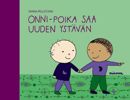 Onni-poika saa uuden ystävän
Onni-poika saa uuden ystävän
[Onni makes a new friend]
Kuvitus [Ill. by]: Sanna Pelliccioni
Helsinki: Minerva, 2012. 32 pp.
ISBN 978-952-492-674-4
€15.90, hardback
The series about a boy named Onni has become a firm favourite among preschool-aged children. Even small children’s picture books are alert to real-life changes in society; in this book – the seventh in the series – Onni gets a new neighbour: a little boy named Aram and Onni quickly become firm friends, even though they do not speak the same language at first. Their friendship across cultural barriers is explained in a straightforward manner that children can grasp. It says something about the introversion of Finnish society and about cultural differences that the friendship is initiated by Aram, who brings some rice pudding made by his mother as a treat for his new neighbours. Pelliccioni’s round-headed figures, characteristic of her style, are suitably simple. She manages to convey fine nuances in their expressions and body language.
Translated by Ruth Urbom
Timo Parvela: Maukka, Väykkä ja Karhu Murhinen [Meowser, Barker and Killington Bear]
24 January 2013 | Mini reviews, Reviews
 Maukka, Väykkä ja Karhu Murhinen
Maukka, Väykkä ja Karhu Murhinen
[Meowser, Barker and Killington Bear]
Kuvitus [Ill. by]: Virpi Talvitie
Helsinki: Tammi, 2012. 127 pp.
ISBN 978-951-31-6167-5
€20.90, hardback
This novel in the Maukka ja Väykkä series tells about friendship among a cat, a dog and a shrew. There is a need for more children’s books for the whole family that can be read aloud. The award-winning duo behind this title have created a book with brief chapters and an engaging setting. Maukka is an attention-seeking cat with a quick temper, while Väykkä is a laid-back, worldly-wise dog. Their life together seems to be a constant squabble over which one of them is right. The latest arrival in the animal community is a little shrew, who has a heart of pure gold despite his fearsome name. He manages to teach the cat-and-dog duo a few things about life. The shrew’s life span is much shorter than that of the cat and dog; Murhinen himself has a sanguine attitude to the matter and teaches Maukka, Väykkä and the reader a number of important things about life and death.
Translated by Ruth Urbom
Katarina von Numers-Ekman: Singer
24 January 2013 | Mini reviews, Reviews
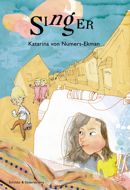 Singer
Singer
Kuvitus [Ill. by]: Jenny Lucander-Holm
Helsinki: Schildts & Söderströms, 2012. 144 pp.
ISBN 978-951-52-3013-3
€17.90, hardback
Singer by Finland-Swedish author Katarina von Numers-Ekman deals with some fairly dark childhood emotions in an intense way, but manages to avoid too much angst. Josefin is an 11-year-old girl who lives alone with her father following the death of her mother. The girl does not dwell daily on the loss of her mum, but as she grows up she finds herself missing her mother more. This novel devotes an unusual amount of space to questions of language and identity through the mother’s British background and the family’s Finland-Swedish heritage. Singer is a clever double reference: Josefin has a Singer brand sewing machine, and the key plot point centres around a singing exam. Josefin goes through a number of embarrassing experiences with her friends. Her feelings of embarrassment or shame are linked with things like poor swimming skills, a classmate’s teasing, or a friend’s grandfather’s alcohol consumption. Katarina von Numers-Ekman manages to infiltrate the world of children’s experiences without making the reader feel like a voyeur. Singer provides numerous points of access to the painful growing-up years of childhood and early adolescence.
Translated by Ruth Urbom
Laura Lähteenmäki: North End: Niskaan putoava taivas [North End: Falling Sky]
24 January 2013 | Mini reviews, Reviews
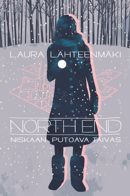 North End: Niskaan putoava taivas
North End: Niskaan putoava taivas
[North End: Falling Sky]
Helsinki: WSOY, 2012. 258 pp.
ISBN 978-951-0-38598-2
€27.90, hardback
The global success of Suzanne Collins’ The Hunger Games trilogy has spurred a boom in dystopian stories in Finland as well. The core themes of independence and friendship familiar from Lähteenmäki’s previous works are also present in this story about the impending end of the world. North End is set in the near future, around 50 years from now. This is hinted at by a reference to Victoria, queen of Sweden (currently a young princess), as a senior citizen. Recycling is a necessary part of daily life, and devices similar to exercise bikes are used to generate electricity at night. Widespread scarcity has forced people to become watchful of others, for good and bad. Tekla, a 14-year-old girl, has moved to North End with her family and is still looking to make new friends. Everyday life is thrown into disarray for Tekla and her younger brother when their separated parents get their custody weeks muddled up, and the children are left to fend for themselves. After the initial rush of freedom, the responsibility begins to frighten the siblings. Relationships and parenthood are put under the microscope on many occasions in this work, which will eventually grow into a trilogy.
Translated by Ruth Urbom
Magdalena Hai: Kerjäläisprinsessa [The Beggar Princess]
24 January 2013 | Mini reviews, Reviews
 Kerjäläisprinsessa
Kerjäläisprinsessa
[The Beggar Princess]
Helsinki: Karisto, 2012. 188 pp.
ISBN 978-951-23-5593-8
€23.90, hardback
Kerjäläisprinsessa by the pseudonymous Magdalena Hai (born 1978) is a steampunk-esque novel for young teens that utilises an inventive alternative version of history. It is set in Greenland in the 1860s, where a community of settlers established by the Vikings has survived a minor ice age. The royal family were forced into exile, but the king is more interested in building curious inventions than saving the nation of Umbrovia. Strange robots and steam-powered inventions liven up the convoluted adventure. Princess Gigi has had to grow up as the object of everyone’s undivided attention. She befriends Henry, a boy from a poor family, and sets about saving her country from a looming threat. There is humour in this book, particularly in the character of Mussovitz, a werewolf: he has an idiosyncratic lisping manner of speaking. It remains to be seen whether Umbrovia will emerge as a nation ruled by powerful women in the subsequent titles in this series.
Translated by Ruth Urbom
Siiri Enoranta: Painajaisten lintukoto [Sweet haven of nightmares]
24 January 2013 | Mini reviews, Reviews
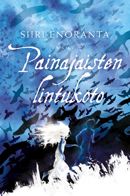 Painajaisten lintukoto
Painajaisten lintukoto
[Sweet haven of nightmares]
Helsinki: WSOY, 2012. 330 pp.
ISBN 978-951-0-38932-4
€26.90, hardback
Siiri Enoranta’s debut novel, Omenmean vallanhaltija (‘The Ruler of Omenmea’, Robustos, 2009) was nominated for the Finlandia Junior award, while another of her novels, Gisellen kuolema (‘The death of Giselle’) was nominated for the Runeberg Prize. Painajaisten lintukoto marks a departure from the genre Enoranta had focused on in her previous works. Her books incorporate the joy of spellbinding, spontaneous fantasy and skill at creating ever more uncanny settings. This novel is situated in the vacillating borderlands between sleep and the waking world. Lunni is a teenage boy who has been set a challenging task of overcoming nightmares and restoring natural sleep to people. The boy is joined by Tui, a mechanical girl. Other important figures in the story are giant tame birds that help Lunni and Tui get from place to place. The prose of Siiri Enoranta (1987) is lyrical, but it also contains points of contact for fans of fantasy writing of many different ages.
Translated by Ruth Urbom
Finnish comics go to France
24 January 2013 | In the news
 The first anthology of Finnish comics in French will be introduced to a French (and international) audience on 1 February at the biggest European comics festival, which takes place in Angoulême, France.
The first anthology of Finnish comics in French will be introduced to a French (and international) audience on 1 February at the biggest European comics festival, which takes place in Angoulême, France.
La Bande dessinée Finlandaise 2013 (published by the Finnish Comics Society and the French publisher Rackham), edited by Johanna Rojola and Kalle Hakkola, features the work of thirteen Finnish female comics artists. Finland is an exception in the comics scene, because a large proportion of the artists in this field are female.
The Finnish participants in Angoulême are FILI (the Finnish Literature Exchange) and the Finnish Comics Society.
